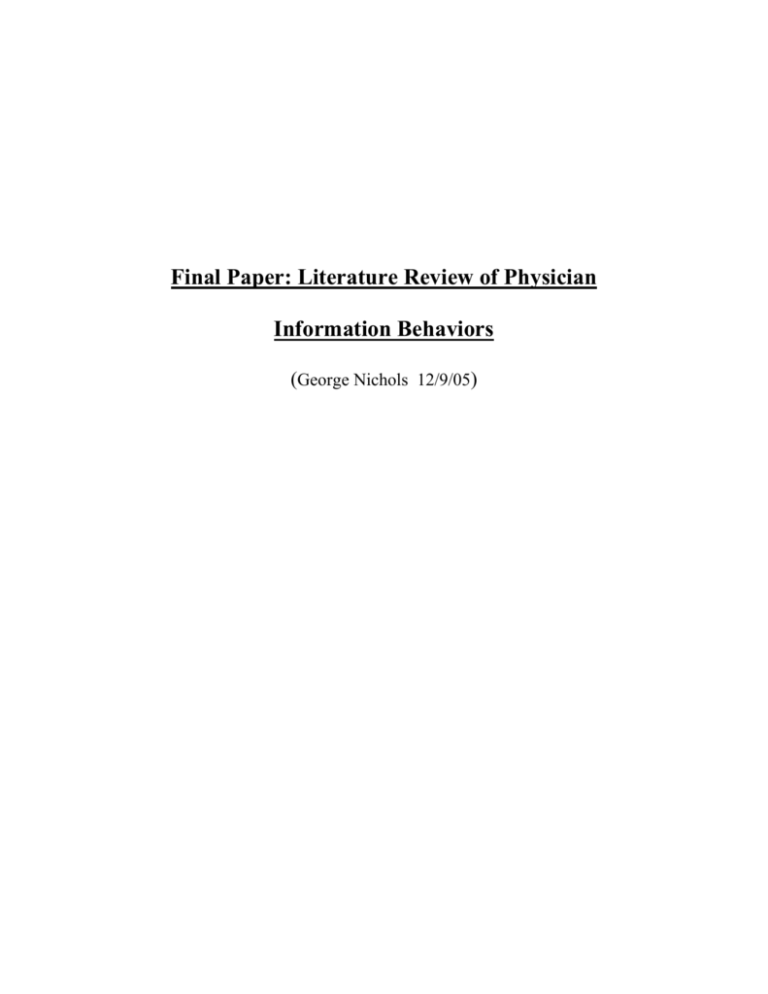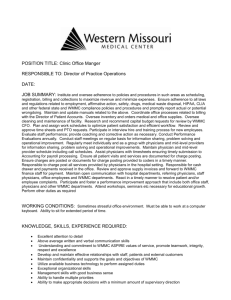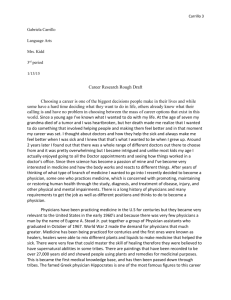Information Behaviors of Physicians
advertisement

Final Paper: Literature Review of Physician Information Behaviors (George Nichols 12/9/05) INTRODUCTION This literature review covers the existing body of research knowledge on physicians' information behaviors. Physicians routinely make choices that have serious consequences on their patients' health; however, little research in recent years has analyzed the information behaviors driving these decisions. This process generally involves doctors identifying information needs through questioning, deciding which resources to consult for answers, and appraising information quality in order to determine the best course of action. PURPOSE OF RESEARCH Information seeking is a topic that has been thoroughly explored by researchers in the last several decades. Yet, only more recently has this body of knowledge expanded to include the study of information behavior, which Case (2002) defines as "encompass[ing] information seeking as well as the totality of other unintentional or passive behaviors (such as glimpsing or encountering information), as well as purposive behaviors that do not involve seeking, such as actively avoiding information." Some of this research has analyzed the subject in the occupational context of healthcare professionals, particularly doctors. At the most fundamental level, this research seeks to answer questions that underlie many other information behavior population studies: What are the knowledge gaps commonly found in this group? What resources are consulted to answer these questions? Why are certain resources preferred over others? Further examples include a study by Gruppen that explicitly asks: "What is the context in which physicians seek additional information?" and "What sources of information will physicians access and find more or less useful?" Researchers must consider additional characteristics inherent to clinical settings. Most notably, this environment includes patients. The stakes of physician decisions are usually measured in patient health outcomes, thereby assigning a greater urgency to doctor questions relative to the information needs of many other populations. In fact, a survey noted that medical library information facilitated lower mortality rates at hospitals in the Rochester, NY area (Quinn, 1991). Also relative to other demographic or vocational groups, doctors stand out by virtue of their extensive training and educational attainment. When making information decisions, doctors draw heavily on a personal knowledge base that includes many years of schooling, residency, and practice. LITERATURE REVIEW The studies in this literature review were located in several databases, particularly ISI Web of Science (accessed through Florida State University's online library). Search terms used include "information seeking" and "information behav*" (single and plural form of both "behavior" and "behaviour"), in conjunction with "doctors," "physicians," or "healthcare." The results were usually abstracts, with additional searches conducted to find each individual article through electronic journals. In many cases, nothing more than an abstract was available. Some of these articles were difficult to obtain given their age-many of these studies were conducted in the 1980's or early 1990's. This search strategy yielded research heavily biased toward English-language journals, and particularly American periodicals. These studies were not conducted in other countries (which comprise the majority of the world's population), thereby limiting the generalizability of research in those areas. The majority of these studies used questionnaires or administered surveys to physicians. Some studies collected data through direction observation. In totality, this physician sample varied widely in field of specialty, age, and experience levels. INFORMATION NEEDS: COMMON DOCTOR QUESTIONS The existing body of research is not particularly deep. Dawes (2003) opines on the "remarkably low number of studies that have explored information seeking behavior of clinicians." Furthermore, much of the research is outdated -- many of the studies were conducted in the early 1990's and prior decades; since then, there have been major changes in the medical field (e.g. evidence-based medicine) and information technology (e.g. adoption of online information sources). Much of this research literature suffers from a lack of depth and generalizability. Specifically (as implied in Detlefsen, 1998), many studies are descriptive in nature using surveys or questionnaires to report actions, but are not prescriptive by providing information behavior models proffering heuristics on the underlying variables driving these behaviors. A rare exception comes from Paul Gorman, a general internist and medical informatics specialist. Gorman made a breakthrough in this area when he introduced a classification model (1995) for two parameters. First, he categorized the type of information used into five groupings: patient data, population statistics, medical knowledge, logistical information, and social influences. Secondly, Gorman classified information needs into four groupings: recognized, pursued, satisfied, unrecognized. These latter four categories may be considered a refinement of Osheroff's (Osheroff et al, 1991) earlier typology that categorized information needs as consciously recognized, unrecognized, or currently satisfied. A key obstacle to the creation of other physician information-behavior models is the lack of standardization in defining terms or classifying phenomena. A study of family practitioners (Ely et al, 1999) addressed this concern by developing a taxonomy to classify most questions under generic types. In doing so, the study found doctors' most common generic questions were: "What is the cause of symptom X?," "What is the dose of drug X?," "How should I manage disease or finding X?," and "How should I treat find or disease X?" Other studies also shed light on information seeking by highlighting the most common types of physician questions. According to Thompson (1997), physicians seek information for two reasons: 1) to obtain answers to patient questions whose answers are not contained in their personal knowledge base, and 2) to stay abreast of developments in their field. Meanwhile, Ely's (1992) study of family physicians found that the most common type of question was about drug prescribing, while orthopedic questions ranked second. DEPENDENCE ON INFORMAL SOURCES This literature review on preferred information sources revealed one particularly salient theme. Most studies indicated that colleagues (e.g. other physicians) were the most preferred information source, by a substantial margin. This may come as a surprise to some casual observers. Indeed, it seems to come as a surprise to physicians themselves considering multiple studies (particularly Covell et al, 1985) found that physicians substantially under-reported (relative to actual numbers) uses of colleagues and/or over-estimated use of text sources. So arises the question "Why the great dependence on colleagues?" Convenience and relevance were among the leading factors (as detailed below in this paper's "evidence-based medicine" discussion). Additionally, the British Medical Journal (Smith, 1996) provided a good description of psychological factors: "...the need for information is often much more than a question about medical knowledge. Doctors are looking for guidance, psychological support, affirmation, commiseration, sympathy, judgment, and feedback. This 'information need' is particularly poorly explored, and yet it may well be the most important need and the biggest stumbling block to a technical solution [medical information system]." BARRIERS TO INFORMATION SEEKING Studies on physicians' information behaviors note that many questions are not pursued, leading researchers to hypothesize why physicians abandon the information seeking process. Gorman & Helfand (1995) noted that only around 30% of questions are pursued and are driven by two specific factors: the urgency of the patient's problem, and the physician's belief that a definitive answer existed. Numerous other studies (Dawes, 2003; Thompson, 1997; Ely et al, 2002) confirm the latter point -- if physicians believe that a clear, relevant answer could not be found in reasonable time then the pursuit for an answer is often abandoned immediately. Electronic sources of information tend to be far less popular than the use of colleagues. There are varying explanations as to why this is the case. Ely (1999) makes a persuasive argument when claiming "Information retrieval systems have been designed for the researcher who needs an exhaustive search on a single topic, not for the practitioner who needs bottom-line answers on the fly." Various barriers strongly affect the information seeking behaviors of certain subpopulations within the physician occupational group. Rural doctors form one such group. (Ely et al, 1992) noted that urban physicians pursued more questions than rural physicians (one question per 9 patients, versus only one per 24 patients, respectively). Use of electronic sources lagged as well--Chimoskey (1999) reported that rural doctors make less use of Medline despite the likelihood they will benefit disproportionately given their relatively limited access to other resources. Lack of time and database searching skills have been among the barriers cited, but the true impact of these variables is unclear since they are also frequently mentioned as barriers for non-rural physicians. LIBRARIANS SUPPLEMENTING PHYSICIAN INFORMATION BEHAVIOR Doctors face a dilemma: It requires significant time and effort for them to conduct literature searches in order to extract useful information for patient treatment. Combined with the fact that they are much more comfortable using colleagues instead of text resources, doctors may be exhibiting deficient information seeking behavior by not seeking the best available information in order to maximize patient welfare. Some research has addressed the feasibility of whether medical librarians can help doctors fill this serious information gap; the results have been mixed. In arguing for "informationists" Davidoff (2000) notes: "the medical profession falls far short in its efforts to make the critical link between the huge body of information hidden away in the medical literature and the information needed at the point of care. This failure means not only that many opportunities for improved patient care and continued learning are missed but also that much of the effort, creativity, and money that go into biomedical research is simply wasted." Such intermediaries have been referred to by various names in the literature: medical librarians, informationists, informaticists, clinical medical librarians, and most interestingly, roving medical librarians (who attend medical rounds alongside doctors). Del Mar (2001) found that general practitioners were generally satisfied with a literature research service, but that cost effectiveness was an issue that warranted further study. A study (Verhoeven & Schuling, 2004) of an evidence-based answering service showed it had an impact on 81% of the participating general practitioners and saved their time. Another study (Gorman et al, 1994) found that librarians, on average, answered questions in 43 minutes at a cost of $27. He found the results encouraging considering librarians provided clear answers to 46% of questions; versus 30% for physicians (using any knowledge source) and just 1 to 2% when physicians used a database such as Medline. EVIDENCE-BASED MEDICINE (EBM): CONFLICTS WITH INFORMATION BEHAVIOR? Evidence-based medicine (EBM) is an approach that has gained tremendous influence in the past decade. Vividly illustrating this trend, a Medline search for the term revealed its first hit in 1992, a handful more in 1993, and skyrocketing to nearly 600 hits in 1997 (Bensing, 2000), and much greater frequency in recent years. Although not yet a household term, EBM is now mentioned frequently in wider contexts (e.g. job postings for medical librarians). A British Medical Journal article (Sackett, 1996) defines EBM as [emphasis added] "the conscientious, explicit, and judicious use of current best evidence in making decisions about the care of individual patients. The practice of evidence based medicine means integrating individual clinical expertise with the best available external clinical evidence from systematic research." This last point is emphasized here due to its tremendous potential impact on physician information behavior. The EBM model is increasingly taught to a new generation of medical students and is taking greater hold in the medical world. This shift poses a serious conflict considering physician information behavior (as illustrated earlier in this paper) clearly contradicts EBM tenets. Rather than conducting extensive literature searches to unearth the best information from external sources, physicians are strongly dependent on their colleagues as information sources. Even in the few cases where they do conduct a thorough literature search, doctors appraise the resulting information based on anecdotal experience rather than the scientific EBM model. Dorsch (2000) points to a study finding that "90% of practitioners compared the findings in the literature to their own experience rather than appraised the findings based on study methodology and statistical significance." Also, Ely (1999) makes this striking observation about physician information behavior: The physician, when faced with an unfamiliar clinical problem, is advised to critically evaluate original research and to practice evidencebased medicine. Studies have found that this advice is generally ignored. Instead, most practicing physicians seek highly digested information from books and colleagues. In the pressure-cooker atmosphere of a busy practice, physicians value rapid access and understandability more than the quality or recency of information. Research on information behaviors in the context of EBM is very scarce, which is why this reviewer strongly believes it is an area clearly meriting further attention. This literature review uncovered only one study (Greenhalgh, 2002) that touched on the issue--albeit indirectly--when noting: "although most clinicians support the notion of evidence based health care in principle and wish to use evidence based information generated by others, only a tiny fraction seek to acquire all the requisite skills themselves...the commonest reason cited [in another study] for not practicing evidence based health care was lack of time." This brief excerpt suggests practitioners endorse EBM in theory but do not have the time to practice it. Further studies should be conducted to determine how thoroughly clinicians support the EBM model, while observing and measuring actual information behaviors to quantify their deviation from the EBM ideal. In self-reports, physicians frequently overestimate their use of certain formal sources; therefore, such research should be in the form of behavioral observations rather than surveys. This research should also focus on the reasons why physicians are not showing a greater incorporation of these methods and whether the dependence on colleagues as an information source will wane among those who do. CONCLUSION A casual observer may errantly assume that doctors are maximizers (rather than satisficers) considering: 1) relative to other populations under study--they are not constrained by deficiencies in education or financial resources and 2) the high stakes (patient welfare and mortality) associated with their decision making. Nevertheless, the research suggests that many physicians accept EBM tenets yet fail to conduct the proper research of literature sources and appraisal of the resulting information. In other words, they appear to be satisficers. Further study is needed to understand such information behaviors and to determine if there are interventions that will--if warranted--modify such behaviors to potentially improve patient outcomes. REFERENCES Bensing, J. A. (2000). Bridging the gap. the separate worlds of evidence-based medicine and patient-centered medicine. Patient Education Counseling, 39(1), 17-25. Case, D. (2002). Looking for Information: A Survey of Research on Information Seeking, Needs, and Behavior. San Diego, CA: Academic Press. Chimoskey, S. J. (1999). Use of medline by rural physicians in washington state. Journal Of The American Medical Informatics Association , 6(4), 332-333. Covell, D. G., Uman, G. C., Manning, P. R. (1985). Information needs in office practice: are they being met?. Annals of Internal Medicine, 103(4), 596-599. Davidoff, F., Florance, V. (2000). The informationist: a new health profession?. Annals of Internal Medicine, 132(12), 996-998. Dawes, M. & Sampson, U. (2003). Knowledge management in clinical practice: a systematic review of information seeking behavior in physicians. International Journal of Medical Informatics, 71(1), 9-15. Del Mar, C. B. (2001). Feasibility of an evidence-based literature search service for general practitioners. Medical Journal of Australia, 75(3), 134-137. Detlefsen, E. G. (1998). The information behaviors of life and health scientists and health care providers: characteristics of the research literature. Bulletin of the Medical Library Association, 86(3), 385-390. Dorsch, J. (2000). Information needs of rural health professionals: a review of the literature. Bulletin of the Medical Library Association, 88, 346-54. Ely, J. W., Osheroff, J. A., Ebell, M. H., Bergus, G. R., Levy, B. T., Chambliss, M. L., Evans, E. R. (1999). Analysis of questions asked by family doctors regarding patient care. British Medical Journal, 319(7206), 358-361. Ely, J. W., Burch, R. J., Vinson, D. C. (1992). The information needs of family physicians: case-specific clinical questions. Journal of Family Practice, 35(3), 265-269. Ely, J. W. (2002). Obstacles to answering doctors' questions about patient care with evidence: qualitative study. British Medical Journal, 324(7339), 710. Ely, J. W. (1999). What clinical information resources are available in family physicians' offices?. Journal of Family Practice, 48(2), 135-139. Greenhalgh, T. (2002). A comparative case study of two models of a clinical informaticist service. British Medical Journal, 324(7336), 524-9. Gorman, P. N. (1995). Information needs of physicians. Journal of the American Society for Information Science, 46(10), 729-736. Gorman, P. N., Helfand, M. (1995). Information seeking in primary care: how physicians choose which clinical questions to pursue and which to leave unanswered. Medical Decision Making, 15(2), 113-119. Gorman, P. N., Ash, J., Wykoff L. (1994). Can primary care physicians' questions be answered using the medical journal literature?. Bulletin of the Medical Library Association, 82(2), 140-146. Osheroff, J. A., Forsythe D. E., Buchanan B. G., Bankowitz, R. A., Blumenfeld, B. H., Miller, R. A. (1991). Physicians' information needs: analysis of questions posed during clinical teaching. Annals of Internal Medicine, 114(7), 576-581. Quinn, J. (1991). Study shows hospital libraries save lives. Library Journal, 116(17), 12. Sackett, D. (1996). Evidence based medicine: what it is and what it isn't. British Medical Journal, 312(7023), 71-72. Smith, R. (1996). What clinical information do doctors need? . BRITISH MEDICAL JOURNAL , 313(7064), 1062-1068. Thompson, M. L. (1997). Characteristics of information resources preferred by primary care physicians. Bulletin of the Medical Library Association, 85(2), 187-192. Verhoeven, A., Schuling, J. (2004). Effect of an evidence-based answering service on gps and their patients: a pilot study. Health Information Library Journal, 21(2), 2735.




![FOR IMMEDIATE RELEASE: [Month, day, year] Contact: [media](http://s3.studylib.net/store/data/007492087_1-8c5dc4ca567a53e8f9891f70a681d457-300x300.png)

